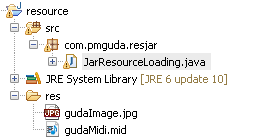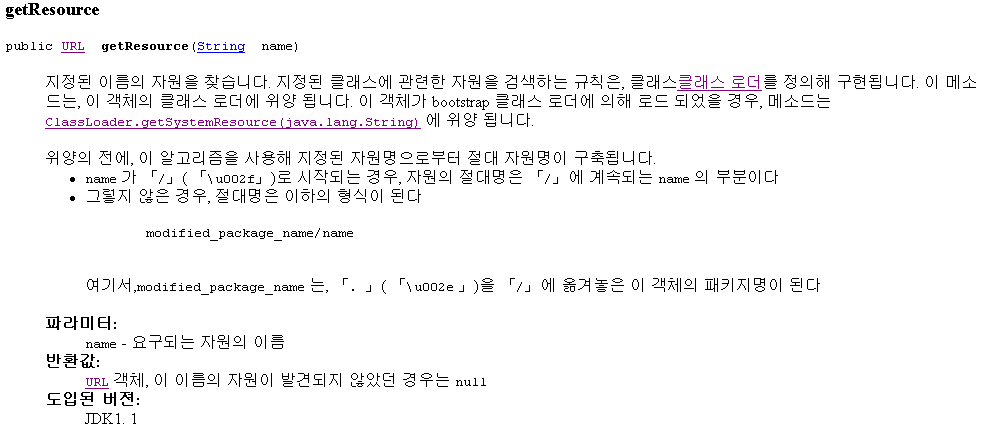반응형
Jar 파일로 응용프로그램을 배포하다 보면 이미지 화일이나 프로퍼티 화일, 자료화일등을
함께 묶어서 배포할 경우가 있다. 해당 자원에 접근하기 위해서는 이전에도 포스팅한바가 있는
java.lang.ClassLoader을 이용해 해당 자원에 접근 할수 있다.
간단한 예를 보자.
ClassLoader loader = this.getClass().getClassLoader();
Icon tIcon = new ImageIcon(loader.getResource("res/tImag.git"));
그 외에도 ClassLoader.getResourceAsStream(String name) 메소드를 이용하여
InputStream을 통한 방법도 있다.
자바웹스타트 환경에서는 Java 2 SE API에서 제공하지 않는 추가적인 기능을 하는 API를
제공한다. 이것은 JNLP API라고 한다. JNLP API를 이용하여 개발할 경우는 jnlp.jar가
필요한데 이러한 파일은 JNLP Developer's Pack에 포함 되어 있다. 다음은 Developer's Pack을
다운로드 할 수 있는 URL이다.
http://java.sun.com/products/javawebstart/download-jnlp.html
JNLP API가 추가적으로 제공하는 클레스는 javax.jnlp package로 묶여 있으며
BasicService, ClipboardService, DownloadService, FileOpenService, FileSaveService,
PrintService, PersistenceService 등이 있는데 이들은 ServiceManager 클레스를 통하여
사용할 수 있다. 각각의 기능은 다음과 같다.
- javax.jnlp.BasicService
BasicService는 웹스타트의 환경적인 면이나 브라우져를 통제하기 위한 API를 제공하는데
자바 애플릿의 경우 AppletContext와 비슷한 역할을 한다. 다음 예제는 웹스타트 환경에서
웹브라우져로하여금 특정 URL로 가도록 하는 것이다.
import javax.jnlp.*;
.....
BasicService bs = (BasicService)ServiceManager.lookup("javax.jnlp.BasicService");
bs.showDocument(new URL("http://www.javanuri.com"));
- javax.jnlp.ClipboardService
ClipboardService는 시스템에서 사용하는 클립보드에서 복사 객체를 가져오거나 클립보드로
복사하는 서비스를 제공한다. 자바웹스타트는 이 기능을 사용할 때 보안을 위하여 경고창을
보여준다. 다음은 간단한 스트링을 클립보드에 복사하는 예제이다.
import javax.jnlp.*;
.............
ClipboardService cs = (ClipboardService)ServiceManager.lookup("javax.jnlp.ClipboardService");
StringSelection ss = new StringSelection("Hello Web Start");
cs.setContents(ss);
- javax.jnlp.DownloadService
DownloadService는 자신의 자원을 Cache에 저장, 삭제등 Cache를 통제할 수 있는 서비스 API를
제공하는 클레스이다. 다음은 myapp.jar를 Cache에서 확인하고 있으면 삭제한후 다시 Cache에
저장하는 예제이다.
import javax.jnlp.*;
...........
DownloadServicd ds = (DownloadService)ServiceManager.lookup("javax.jnlp.DownloadService");
URL url = new URL("http://www.javanuri.com/jws/myapp.jar");
boolean isCached = ds.isResourceCached(url, "1.0");
if(isCached) {
ds.removeResource(url, "1.0");
}
DownloadServiceListener dsl = ds.getDefaultProgressWindow();
ds.loadResource(url, "1.0", dsl);
- javax.jnlp.FileOpenService
FileOpenService는 권한이 제약된 환경에서도 이를 사용자에게 알리고 화일을 열 수 있는
다이얼로그 윈도우를 열어주는 서비스이다. 다음 예제는 FileOpenService를 이용하여 화일을
여는 예제이다.
import javax.jnlp.*;
..............
FileOpenService fo = (FileOpenService)ServiceManager.lookup("javax.jnlp.FileOpenService");
FileContents fc = fo.openFileDialog(null, null);
- javax.jnlp.FileSaveService
FileSaveService는 권한이 제약된 환경에서도 local disk에 화일을 저장할 수 있는
기능을 제공하는 서비스 클레스이다. 이는 FileOpenService의 경우와 반대인 기능을 제공하는
클레스이다. 다음은 FileOpenService를 이용하여 화일을 연 후에 FileSaveService를
이용하여 화일을 저장하는 예제이다.
import javax.jnlp.*;
.....................
FileOpenService fo = (FileOpenService)ServiceManager.lookup("javax.jnlp.FileOpenService");
FileContents fc = fo.openFileDialog(null, null);
FileContents newfc = fss.saveFileDialog(null, null, fc.getInputStream(), "newfile.txt");
- javax.jnlp.PrintService
PrintService는 권한이 제약된 웹스타트 환경에서도 프린트를 가능하게 해주는 API 를 갖고 있는
서비스 클레스이다. 이 API를 이용하여 프린트를 요청하면 사용자에게 허가할 것인가를 묻는
다이얼로그가 나타난다. 다음은 PrintService를 이용한 프린트 요청 예제이다.
import javax.jnlp.*;
.....................
PrintService ps = (PrintService)ServiceManager.lookup("javax.jnlp.PrintService");
// default page format
PageFormat pf = ps.getDefaultPage();
// customizing page format
PageFormat npf = ps.showPageFormatDialog(pf);
// print
ps.print(new Doc());
// printable class
class Doc implements Printable {
....
public int print(Graphics g, PageFormat fm, int idx) {
....
}
}
}
- javax.jnlp.PersistenceService
PersistenceService는 브라우져의 쿠키와 마찬가지고 사용자의 클라이언트에 간단한 자료를
저장할 때 사용된다. 저장되는 형태는 url형태로 자장된다.
다음은 간단한 url을 저장하고 내용을 읽어들이는 예제이다.
import javax.jnlp.*;
.....................
PersistenceService ps = (PersistenceService)ServiceManager.lookup("javax.jnlp.PersistenceService");
String addr = "www.javanuri.com/some.txt";
java.net.URL = new URL(addr);
// create
ps.create(url, 1024);
FileContents fc = ps.get(url);
OutputStream os = fc.getOutputStream(false);
os.write(...);
// read
fc = ps.get(url);
InputStream in = fc.getInputStream();
in.read(...);
.......
- javax.jnlp.FileContents
FileContents 는 FileOpenService, FileSaveService, PersistenceService와 같은 서비스에서
input과 output을 처리할 수 있도록 만들어진 클레스이다. 일반적인 File 클레스와 비슷하게
생각하면 된다. 보안과 자료 저장 형태 등이 일반 File 클레스와는 다르다.
함께 묶어서 배포할 경우가 있다. 해당 자원에 접근하기 위해서는 이전에도 포스팅한바가 있는
java.lang.ClassLoader을 이용해 해당 자원에 접근 할수 있다.
간단한 예를 보자.
ClassLoader loader = this.getClass().getClassLoader();
Icon tIcon = new ImageIcon(loader.getResource("res/tImag.git"));
그 외에도 ClassLoader.getResourceAsStream(String name) 메소드를 이용하여
InputStream을 통한 방법도 있다.
자바웹스타트 환경에서는 Java 2 SE API에서 제공하지 않는 추가적인 기능을 하는 API를
제공한다. 이것은 JNLP API라고 한다. JNLP API를 이용하여 개발할 경우는 jnlp.jar가
필요한데 이러한 파일은 JNLP Developer's Pack에 포함 되어 있다. 다음은 Developer's Pack을
다운로드 할 수 있는 URL이다.
http://java.sun.com/products/javawebstart/download-jnlp.html
JNLP API가 추가적으로 제공하는 클레스는 javax.jnlp package로 묶여 있으며
BasicService, ClipboardService, DownloadService, FileOpenService, FileSaveService,
PrintService, PersistenceService 등이 있는데 이들은 ServiceManager 클레스를 통하여
사용할 수 있다. 각각의 기능은 다음과 같다.
- javax.jnlp.BasicService
BasicService는 웹스타트의 환경적인 면이나 브라우져를 통제하기 위한 API를 제공하는데
자바 애플릿의 경우 AppletContext와 비슷한 역할을 한다. 다음 예제는 웹스타트 환경에서
웹브라우져로하여금 특정 URL로 가도록 하는 것이다.
import javax.jnlp.*;
.....
BasicService bs = (BasicService)ServiceManager.lookup("javax.jnlp.BasicService");
bs.showDocument(new URL("http://www.javanuri.com"));
- javax.jnlp.ClipboardService
ClipboardService는 시스템에서 사용하는 클립보드에서 복사 객체를 가져오거나 클립보드로
복사하는 서비스를 제공한다. 자바웹스타트는 이 기능을 사용할 때 보안을 위하여 경고창을
보여준다. 다음은 간단한 스트링을 클립보드에 복사하는 예제이다.
import javax.jnlp.*;
.............
ClipboardService cs = (ClipboardService)ServiceManager.lookup("javax.jnlp.ClipboardService");
StringSelection ss = new StringSelection("Hello Web Start");
cs.setContents(ss);
- javax.jnlp.DownloadService
DownloadService는 자신의 자원을 Cache에 저장, 삭제등 Cache를 통제할 수 있는 서비스 API를
제공하는 클레스이다. 다음은 myapp.jar를 Cache에서 확인하고 있으면 삭제한후 다시 Cache에
저장하는 예제이다.
import javax.jnlp.*;
...........
DownloadServicd ds = (DownloadService)ServiceManager.lookup("javax.jnlp.DownloadService");
URL url = new URL("http://www.javanuri.com/jws/myapp.jar");
boolean isCached = ds.isResourceCached(url, "1.0");
if(isCached) {
ds.removeResource(url, "1.0");
}
DownloadServiceListener dsl = ds.getDefaultProgressWindow();
ds.loadResource(url, "1.0", dsl);
- javax.jnlp.FileOpenService
FileOpenService는 권한이 제약된 환경에서도 이를 사용자에게 알리고 화일을 열 수 있는
다이얼로그 윈도우를 열어주는 서비스이다. 다음 예제는 FileOpenService를 이용하여 화일을
여는 예제이다.
import javax.jnlp.*;
..............
FileOpenService fo = (FileOpenService)ServiceManager.lookup("javax.jnlp.FileOpenService");
FileContents fc = fo.openFileDialog(null, null);
- javax.jnlp.FileSaveService
FileSaveService는 권한이 제약된 환경에서도 local disk에 화일을 저장할 수 있는
기능을 제공하는 서비스 클레스이다. 이는 FileOpenService의 경우와 반대인 기능을 제공하는
클레스이다. 다음은 FileOpenService를 이용하여 화일을 연 후에 FileSaveService를
이용하여 화일을 저장하는 예제이다.
import javax.jnlp.*;
.....................
FileOpenService fo = (FileOpenService)ServiceManager.lookup("javax.jnlp.FileOpenService");
FileContents fc = fo.openFileDialog(null, null);
FileContents newfc = fss.saveFileDialog(null, null, fc.getInputStream(), "newfile.txt");
- javax.jnlp.PrintService
PrintService는 권한이 제약된 웹스타트 환경에서도 프린트를 가능하게 해주는 API 를 갖고 있는
서비스 클레스이다. 이 API를 이용하여 프린트를 요청하면 사용자에게 허가할 것인가를 묻는
다이얼로그가 나타난다. 다음은 PrintService를 이용한 프린트 요청 예제이다.
import javax.jnlp.*;
.....................
PrintService ps = (PrintService)ServiceManager.lookup("javax.jnlp.PrintService");
// default page format
PageFormat pf = ps.getDefaultPage();
// customizing page format
PageFormat npf = ps.showPageFormatDialog(pf);
ps.print(new Doc());
// printable class
class Doc implements Printable {
....
public int print(Graphics g, PageFormat fm, int idx) {
....
}
}
}
- javax.jnlp.PersistenceService
PersistenceService는 브라우져의 쿠키와 마찬가지고 사용자의 클라이언트에 간단한 자료를
저장할 때 사용된다. 저장되는 형태는 url형태로 자장된다.
다음은 간단한 url을 저장하고 내용을 읽어들이는 예제이다.
import javax.jnlp.*;
.....................
PersistenceService ps = (PersistenceService)ServiceManager.lookup("javax.jnlp.PersistenceService");
String addr = "www.javanuri.com/some.txt";
java.net.URL = new URL(addr);
// create
ps.create(url, 1024);
FileContents fc = ps.get(url);
OutputStream os = fc.getOutputStream(false);
os.write(...);
// read
fc = ps.get(url);
InputStream in = fc.getInputStream();
in.read(...);
.......
- javax.jnlp.FileContents
FileContents 는 FileOpenService, FileSaveService, PersistenceService와 같은 서비스에서
input과 output을 처리할 수 있도록 만들어진 클레스이다. 일반적인 File 클레스와 비슷하게
생각하면 된다. 보안과 자료 저장 형태 등이 일반 File 클레스와는 다르다.


